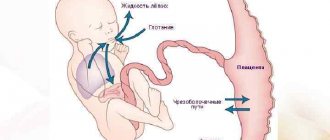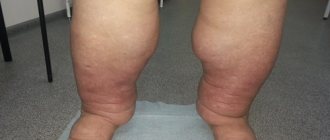Netter F.: Atlas of Human Anatomy. 6th Edition. — Saunders, 2014. — 640 p. Premature aging of the placenta is rare among expectant mothers. But since this is dangerous for the baby, it is important to know why the placenta ages, what affects these processes and how to stop the aging of the placenta. In this article we will talk about what a placenta is and explain everything you need to remember.
Causes of premature ripening of the placenta
The placenta is an organ that, while carrying a child in the womb, goes through several natural stages of development.
The gradual depletion of resources in a child's place is a normal phenomenon. But if this process progresses too quickly, obstetricians talk about premature aging of the placenta. Possible causes of premature aging of the placenta:
- fluctuations in a woman’s body weight (hypotrophy or severe obesity);
- the presence of chronic endocrine or somatic diseases (diabetes, uncontrolled arterial hypertension, thyroid pathology);
- history of surgical termination of pregnancy (abortion);
- injuries accompanied by a violation of the integrity of the walls of the uterus, incl. operations on the uterus;
- drinking alcohol, smoking or using drugs during pregnancy;
- negative impact of environmental factors, household chemicals;
- various viral and bacterial diseases that arose during pregnancy;
- severe toxicosis;
- Rh conflict between the maternal and child organisms.
Due to the influence of these factors, the normal function of the placenta is disrupted. The child's seat works under excessive load, which over time leads to decompensation, which is a direct prerequisite for early aging.
The placenta is an important organ that is directly involved in the development of the unborn child. Through it, oxygen and nutrients are supplied to the fetus, as well as carbon dioxide and other waste products of the baby are removed.
In addition, the placenta has a protective function - it is it that protects the baby from all kinds of infections and reactions of the mother’s immune system. The formation of this organ begins approximately 12 days after fertilization, and only by the 37th week of pregnancy does the placenta reach maturity.
Aging of the placenta is a natural and inevitable process. The stage of its maturity is determined by the doctor during an ultrasound scan.
The following degrees of placental maturity are distinguished:
0 degree – up to 30 weeks;
1st degree – from 27 to 34 weeks;
2nd degree – from 34 to 39 weeks;
Grade 3 – after 37 weeks.
But in practice, the degree of maturity of the placenta does not always correspond to the period of gestation: for example, it happens that stage 3 is diagnosed in an expectant mother at an earlier stage, up to 37 weeks. In this case, they talk about premature aging of the placenta. Why does this happen, why is this condition dangerous and how to cope with it: the answers to these questions can be found in our article. Causes of premature aging of the placenta There are many factors that can trigger the development of this pathology.
Doctors identify the following causes of premature aging of the placenta: Diseases of the endocrine system (diabetes mellitus, thyroid disorders); Traumatic injuries to the uterus (previous abortions or difficult births); Chronic diseases of the cardiovascular system, kidneys and other organs; Bad habits (smoking, alcohol, drugs); Toxicosis of the second half of pregnancy; Rhesus conflict between mother and child; The presence of infectious diseases (toxoplasmosis, mycoplasmosis, herpes, cytomegalovirus, chlamydia, etc.); Little or polyhydramnios; Multiple pregnancy; Blood clotting disorder. Diagnosis of premature aging of the placenta Signs of premature aging of the placenta can be seen during ultrasound, as well as in the results of histological examination of the tissues of this organ after childbirth. However, it is worth noting that ultrasound cannot be called an objective research method. It happens that one doctor can see stage 2 maturity of the placenta, while another, using the same device, diagnoses stage 3 and talks about aging. Remember that ultrasound data are only the basis for additional examination and CTG of the fetus if the detected changes do not correspond to the gestation period.
With premature aging, ultrasound clearly shows that the placental tissue has become more dense. New vessels no longer appear, and the boundaries between the placenta and the wall of the uterus are increasingly visible. Sometimes calcium begins to be deposited in the organ, which ultrasound shows as small white inclusions. As it develops, the thickness and width of the placenta increases, and by the end of the gestation period its size decreases somewhat. What are the consequences of premature aging of the placenta? The consequences of premature maturation of the placenta can be very different, but this pathology does not always end sadly. If aging begins a little earlier than expected, then there is nothing dangerous about it. Sometimes the earlier onset of this process is due to the woman’s physiology, and therefore does not require treatment. If the maturation of the placenta began before the 36th week, and its growth is observed before the 30th week, most likely we are talking about premature aging of the placenta.
What does this mean? The organ no longer copes with its tasks in full - the baby begins to receive less oxygen and nutrients, which can result in malnutrition (low weight of the child) or intrauterine hypoxia. Another consequence of premature aging of the placenta may be a disruption of the blood supply to the fetus. This pathological condition can result in early rupture of amniotic fluid, miscarriage, placental abruption, etc. To prevent this, it is necessary to take appropriate measures in time.
Therapy for such a pathology as early maturation of the placenta should be prescribed only on the basis of the results of a comprehensive examination and the conclusion of a gynecologist that there is still a problem. It is impossible to completely get rid of this, so the actions of doctors will be aimed at maintaining the condition of the pregnant woman and the fetus. As a rule, treatment of premature aging of the placenta involves the elimination of risk factors, as well as complex drug therapy aimed at improving organ function and preventing intrauterine hypoxia. The expectant mother may need to lose weight, stop smoking, treat infections and gestosis, or take medications to reduce toxic effects on the fetus. It is also possible to restore blood circulation in the placenta and ensure the supply of oxygen and nutrients to the fetus with the help of medications. You should not refuse if the doctor suggests that the woman go to the hospital to carry out all the manipulations. Hospitalization is necessary to provide the expectant mother with full assistance. Some time after the start of therapy for premature aging of the placenta, the gynecologist prescribes repeated examinations: ultrasound, CTG, Doppler. Sometimes, with early maturation, labor is artificially stimulated earlier than the expected time, which allows the child to be born without serious pathologies. Remember that during pregnancy you need to regularly visit your doctor and not refuse the tests and examinations that he recommends. Timely detection of premature aging of the placenta is the key to successful treatment and the birth of a healthy baby.
Classification
The classification of placental aging is based on the degree of maturity of the corresponding organ. The baby's place is formed from the chorion. This process ends by the 15-16th week of pregnancy. But the placenta begins to fully function by the 18-20th week. In obstetrics, there are 4 stages of child development:
- 0 degree
- lasts until the 29-30th week;
- 1st degree
- up to 30-32nd;
- 2nd degree
- up to 32-36;
- 3rd degree
- from the 37th to the 40th week.
The degree of organ maturity can be determined using ultrasound diagnostics. Therefore, it is very important to follow the ultrasound schedule during pregnancy. If there is a too early transition from one degree to another, then we can talk about premature maturation of the placenta. You can get a high-quality ultrasound during pregnancy in Moscow at. Experienced doctors provide full patronage to expectant mothers. If necessary, the optimal treatment is selected, which allows you to carry and give birth to a healthy baby, as well as prevent the development of complications.
How is the placenta diagnosed?
Diagnosis is made by ultrasound examination of the placenta using Doppler. It is necessary to identify the degree of placental insufficiency, disturbances in the blood vessels, determine the functioning of the fetal heart, whether there is umbilical cord entanglement. If an ultrasound of the fetus previously determined aging of the placenta, but a Doppler study does not show a violation of the coronary blood flow, the doctor prescribes an additional research method - fetal cardiography.
Pathogenesis
The second planned ultrasound during pregnancy (20-24th week) in most cases is not indicative of diagnosing the corresponding problem. For the first time, it is possible to detect early maturation of an organ mainly at 27-28 weeks, when the degree of development of the child’s place changes from 0 to 1.
Normally, the structure of the placenta is homogeneous, without undulations. At the first stage of maturity, the body of the organ becomes thicker. Ultrasound shows zones of hyperechogenicity. The first irregularities appear on the chorionic plate.
When exposed to negative factors, a premature transition of the placenta to the second degree of maturity occurs. The number of zones of hyperechogenicity increases, small inclusions appear, and irregularities on the chorionic plate deepen.
The third degree is characterized by the lobar structure of the placenta, blood flow through the vessels to the fetus is reduced, and calcifications can form in the parenchyma of the organ. The described changes can be diagnosed when the third ultrasound is performed during pregnancy (32-34 weeks).
Diagnostic procedures
Premature ripening of the placenta is a diagnosis that can only be made after an ultrasound examination. The ultrasound method helps to accurately determine the presence of changes in the structure of the placenta (calcium deposits, cysts, compactions) and the correspondence of these changes to the duration of pregnancy.
During an ultrasound scan, the condition of the fetus is determined, the doctor pays attention to the heart rate, the size of the fetus, all indicators are recorded and correlated with the woman’s gestational age.
To confirm the diagnosis, Doppler ultrasound of the uteroplacental blood flow is performed, a general blood test and coagulogram are examined, and the level of placental hormones (estriol, human chorionic gonadotropin, placental lactogen) is determined. The fetal condition is monitored through cardiotocography (CTG), fetometry, and fetal phonocardiography. If necessary, a consultation with related specialists is scheduled: therapist, infectious disease specialist, cardiologist, etc.
Symptoms of premature ripening of the placenta
There are no specific symptoms of premature maturation of the child's place on the part of the expectant mother. The woman clinically does not feel the placenta aging too quickly, which cannot be said about the child.
Due to a decrease in the supply of oxygen and nutrients to the baby’s body, the functional activity of its internal structures changes.
Possible signs:
- excessive mobility of the child in the womb or its sharp decrease, which is a more unfavorable prognostic sign;
- acceleration of the baby’s heart rate, which slows down as the pathology of the condition progresses.
The third planned ultrasound during pregnancy is often the first examination that demonstrates the presence of a possible problem. To select adequate treatment, further diagnostics using a cardiotocograph and an ultrasound machine are required. An assessment of the quality of blood flow through the vessels from mother to child is carried out when Doppler ultrasound is performed during pregnancy. The technique allows you to visualize the movement of blood and establish the adequacy of the corresponding process.
What is the placenta and why is it needed?
The content of the article
The placenta is a network of tubes that includes 2 circulatory systems - the woman and the fetus. The organ completely ensures the life of the baby in the uterus, performing vital functions:
- Nutritious
. Thanks to the placenta, the embryo receives all nutrients, vitamins, and electrolytes from the mother. - Excretory.
With the blood flow, waste products of the fetus are removed from the placenta: (urea, creatine). - Respiratory
. The baby receives oxygen from the mother and releases carbon dioxide. - Protective or immune
. Mother's antibodies that cross the placenta protect the unborn child from various immune diseases. - Endocrine
. Estrogens, progesterones, serotonin and other hormones are formed in the placenta, promoting the development of the organ and bearing a child.
Without the placenta, the fetus will die because it will not be able to breathe or eat.
Degrees of placenta maturity
As we have already said, at the end of pregnancy, physiological aging of the placenta occurs, accompanied by a decrease in its surface area and the appearance of areas of salt deposition (calcifications). As the placenta ages, it goes through 4 stages of maturity (according to the Grannum PA 1979 classification):
0 degree; in this case, the placenta has a homogeneous or fine-grained ultrasonic structure; its thickness varies between 1.5-2 cm; the chorionic plate does not yet give an echographic reflection; the boundary between the placental tissue and the muscular layer of the uterus is not clearly defined; the fruit surface has smooth or wavy contours; Normally, grade 0 is determined before 30 weeks of pregnancy;
I degree; a medium-grained ultrasound structure is determined in the placenta; thickness increases from 2 to 3 cm; a reflection appears from the chorionic plate, it becomes tortuous; the boundary between the placenta and the uterus is clearly defined; I degree is observed at 30-34 weeks;
II degree (lobular placenta II); its thickness ranges from 2.5 to 3.5 cm; there are single or multiple inclusions on the placental septa; observed at 34-37 weeks;
III degree (lobular placenta III); there is a significant number of inclusions in the structure of the placenta, on the interlobar septa and on its maternal surface; III degree is typical for 37-40 weeks.
Determining the degree of maturation is necessary to assess the ability of the placenta to supply the baby with sufficient amounts of nutrients. The discrepancy between the degree of maturity of the placenta and the gestational age is accompanied by the risk of developing various complications.
Hospital or...
Regime and diet
If premature aging of the placenta is detected, comprehensive treatment is carried out in a hospital setting. Treatment is aimed at eliminating risk factors, normalizing blood flow and preventing fetal hypoxia. Treatment in a hospital allows you to provide full assistance to mother and child.
A woman is recommended physical and emotional rest, nutritious nutrition rich in vitamins and minerals. The expectant mother is advised to avoid fried, smoked and salty foods, limit flour products and sugar consumption in general. It is necessary to increase the amount of vegetables and fruits in the diet.
Main groups of drugs
The basis is drug treatment.
To improve uterine-placental blood flow, pentoxifylline is indicated for a course of 10-14 days. This drug has vasodilating, angioprotective and antiaggregation properties.
In order to prevent oxygen starvation of the fetus, drugs such as Actovegin or Curantil are used. The main effects of these antihypoxants are metabolic, microcirculatory and neuroprotective. The absorption and utilization of oxygen increases, capillary blood flow improves, and the condition of the central and peripheral nervous system improves.
Correction of the rheological properties of blood occurs with the help of Acetylsalicylic acid, Dextran.
Metabolic therapy is carried out with the help of vitamin E, methionine, folic acid. Ascorbic acid and dry (aqueous) extract of artichoke leaves also improve placental function.
If necessary, sedative therapy is indicated. The drugs of choice are valerian tincture, peony tincture, motherwort tincture, herbal teas (sedative mixtures).









